Our Lady of Knock
Queen of Ireland and Mother of the Church
Now an International Marian and Eucharistic Shrine
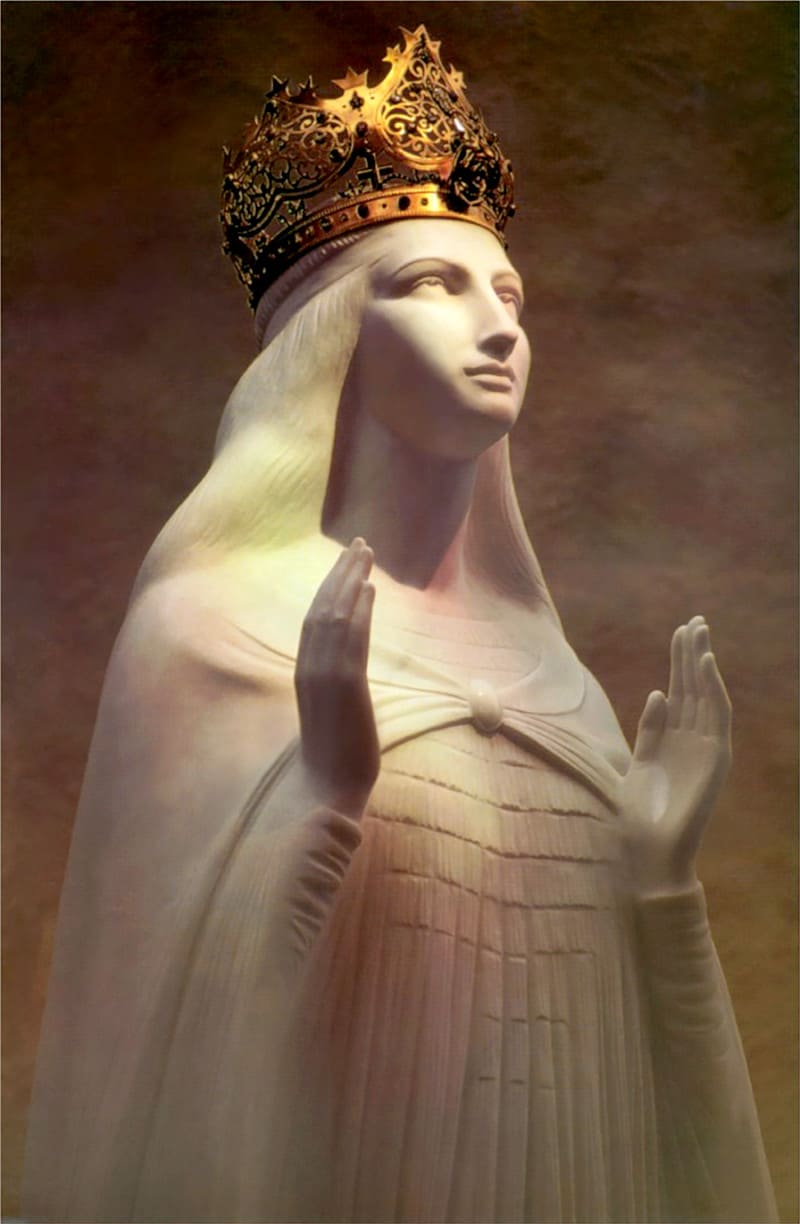 Our Lady of Knock as she appeared in 1879
Our Lady of Knock as she appeared in 1879Less famous than the shrine at Lourdes or Guadalupe, Knock is the site of a Marian apparition that has inspired generations. Pope Francis is among the countless pilgrims who visited the shrine of Knock. Earlier this year, on the Feast of St. Joseph (March 19, 2021), in a video created for the people of Ireland and live-streamed at the shrine, the pontiff said that "Our Lady of Knock exemplifies the importance of prayer and hope", as he officially designated the Knock Shrine an International Marian and Eucharistic Shrine.
"Our Lady of Knock's silence still contains an important message," Pope Francis said. "The message which comes from Knock is that of the great value of silence for our faith. …It is this silence in the face of mystery, which does not mean giving up on understanding, but understanding while aided and supported by the love of Jesus who offered Himself for all of us as the Lamb sacrificed for the salvation of humanity. It is this silence in the face of the great mystery of a love which cannot be reciprocated unless in trusting abandonment to the will of the merciful Father."
Pope Francis, dedicated the year to St. Joseph (December 8, 2020 to December 8, 2021). He announced the Year of the Family to the world from his livestream in Knock, beginning on March 19, 2021, the feast of St. Joseph, and ending on the same feast day in 2022. Francis praised the people of Ireland, saying: "How many families in the course of almost a century and a half have handed on the faith to their children and gathered their daily labors around the prayer of the rosary, with the image of Our Lady of Knock at its centre? …The arms of the Virgin, outstretched in prayer, continue to show us the importance of prayer as the message of hope which goes out from this shrine."
Pope Francis acknowledged that the Irish have been a "missionary people", and expressed gratitude for the many priests who left Ireland to proclaim the Gospel as missionaries as well as the "many lay people who emigrated to faraway lands but still kept their devotion to Our Lady. Ever since the apparition on August 21, 1879, when the Blessed Virgin Mary, together with St. Joseph and St. John the Apostle, appeared to some villagers, the Irish people, wherever they have found themselves, have expressed their faith and devotion to Our Lady of Knock."
Ever since their conversion to Christianity in the first half of the fifth century by St. Patrick, the Irish have possessed a particularly strong devotion to the Blessed Virgin Mary. This devotion to the Mother of God, which was handed on to them by St. Patrick himself, has been the source of their consolation during centuries of persecution because of their steadfastness to the One, True Catholic Faith. It has also been their comfort and assistance during the bleakest of times.
Despite the Emancipation Act of 1829, which was to guarantee religious freedom to Ireland's Catholics, persecution persisted in the 19th century. During the same time, the country experienced calamity: potato crop failures that culminated in the Great Potato Famine and a deadly epidemic of typhoid fever. Catholics were encouraged to abandon their ancient faith through bribes of food and money, but it was with courageous heroism that they turned to Mary Immaculate, Cause of our Hope, and on a rainy August evening in 1879, in a small county town, Mary once again sustained her children, comforting them in a time of great need by her presence among them.
Our Lady of Knock
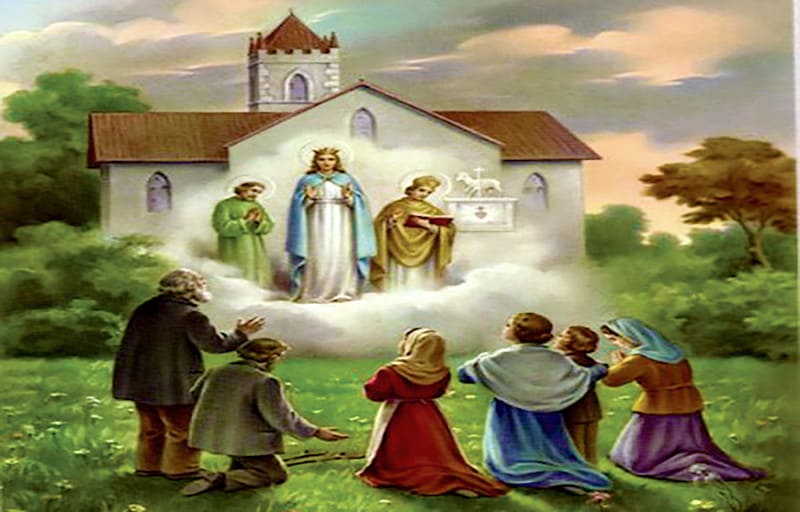 The small town of Knock, in the province of Connacht, County Mayo, is better known to the Irish people as Cnoc Mhuire, or Hill of Mary. It is situated in the western part of Ireland, with a population of about 2000 inhabitants and has become the destination of 1.5 million pilgrims each year who travel from all parts of Ireland and the world to pay homage to the Mother of God.
The small town of Knock, in the province of Connacht, County Mayo, is better known to the Irish people as Cnoc Mhuire, or Hill of Mary. It is situated in the western part of Ireland, with a population of about 2000 inhabitants and has become the destination of 1.5 million pilgrims each year who travel from all parts of Ireland and the world to pay homage to the Mother of God.
The evening of August 21st, 1879 was rainy. Several people reported seeing a bright light shining over the church of St. John the Baptist. Fifteen witnesses testified they saw the figures of the Blessed Virgin Mary, St. Joseph and St. John the Evangelist. To the left there was a cross and a lamb on an altar surrounded by angels. Mary Byrne, one of the 15 witnesses gave this detailed testimony to a Commission of Inquiry investigating the happenings at Knock:
"The Blessed Virgin was life-size, the others apparently either not so big or not so high as her figure. They stood a little distance out from the gable wall, and, as well as I could judge a foot and a half or two feet from the ground. The Virgin stood erect with eyes raised to heaven; her hands elevated to the shoulders or a little higher, the palms inclined slightly towards the shoulders or bosom. She wore a large cloak of a white color, hanging in full folds and somewhat loosely around her shoulders and fastened to the neck. She wore a crown on the head, rather a large crown, and it appeared to me somewhat yellower than the dress or robes worn by Our Blessed Lady.
"In the figure of St. Joseph the head was slightly bent and inclined towards the Blessed Virgin as if paying her respect. It represented the saint as somewhat aged, with grey whiskers and greyish hair.
"The third figure appeared to be that of St. John the Evangelist. I do not know, only I thought so, except the fact that at one time I saw a statue at the chapel of Lecanvey near Westport, County Mayo very much resembling the figure which stood now before me in a group with St. Joseph and Our Blessed Lady which I beheld on this occasion. He held the Book of Gospels, or the Mass Book, open in his left hand while he stood slightly turned on the left side towards the altar that was over a little from him.
"I must remark that the statue which I had formerly seen at Lecanvey chapel had no miter on its head, while the figure which I now beheld had one, not a high miter, but a short set kind of one. The statue at Lecanvey had a book in the left hand and the fingers of the right hand raised. The figure before me on this present occasion of which I am speaking had a book in the left hand, as I have stated, and the index finger and the middle finger of the right hand raised as if he were speaking and impressing some point forcibly on an audience. It was this coincidence of figure and pose that made me surmise, for it is only an opinion, that the third figure was that of St. John, the beloved disciple of Our Lord but I am not in any way sure what saint or character the figure represented. I said, as I now expressed, that it was St. John the Evangelist and then all the others present said the same – said what I stated.
"The altar was under the window which is in the gable and a little to the west near the centre or a little beyond it. Towards this altar, St. John, as I shall call the figure, was looking while he stood at the Gospel side of the said altar with his right arm inclined at an angle outwardly towards the Blessed Virgin. The altar appeared to be like the altars in use in the Catholic Church, large and full-sized. It had no linens, no candles, nor any special ornamentations; it was only a plain altar. Above the altar and resting on it was a lamb standing with the face towards St. John, thus fronting the western sky. I saw no cross or crucifix. On the body of the lamb and around it I saw golden stars, or small brilliant lights, glittering like jets or glass balls reflecting the light of some luminous body. I remained from a quarter past eight to half past nine o'clock. At the time it was raining."
One other witness, young Patrick Hill, who dared to venture very close to the apparition claimed that the "lights" were actually angels. "Around the Lamb I saw angels hovering during the whole time, for the space of one hour and a half or longer; I saw their wings fluttering but I did not perceive their heads or faces which were not turned to me."
Three additional apparitions of this same tableau occurred on January 6, February 10, and February 12, 1880.
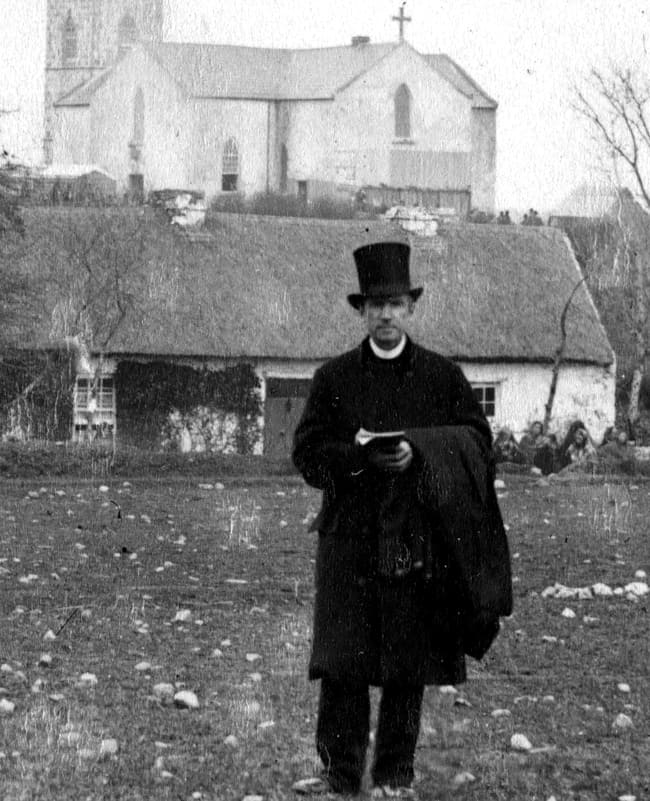 Archdeacon Bartholomew Cavanagh Pastor of Knock at the time of the apparition
Archdeacon Bartholomew Cavanagh Pastor of Knock at the time of the apparitionImmediately, miracles and healings began to occur. The Pastor of the little church of Knock at the time of the apparition, Archdeacon Bartholomew Cavanagh (1867-1897), recorded everything scrupulously in his diary. He was a holy priest, known to be very devoted to the Blessed Virgin Mary. Only one month prior to the events at Knock he had begun saying one hundred Masses in honor of the Virgin for the release of the poor souls in Purgatory. He unreservedly opened his church to all the pilgrims coming to pay homage to the Virgin, saying many extra Masses a day and making himself available to all in the confessional day and night.
After his death on December 8th, 1897, he was laid to rest in the parish church. The people of Knock erected a memorial tablet to their beloved Pastor which remains as a beautiful testimony to his holiness: "Pray for the soul of the Venerable Archdeacon Cavanagh, Archdeacon of the Chapter of Tuam, and parish of Knock-Aghamore, whose fame, on account of the extraordinary sanctity of his life and his devotion to the Mother of God, was diffused thus far and wide. Unwearying in the Confessional, assiduous in works of piety, he died, full of years and merits, December 9th, 1897, R.I.P."
The unusual aspects of this apparition at Knock when compared with other apparitions throughout the world (e.g Fatima, Gietrzwald and Lourdes) are that Our Lady, St. Joseph, and St. John all remained silent and that the Blessed Mother gave no message of warning or reproof. She did not make any requests nor offer words of consolation. So, why then did these celestial personages make themselves seen to the fifteen witnesses of all ages who were present on that day? Monsignor James Horan who was the Pastor at Knock from 1967-1986 explained that "Our Lady's appearance in Knock [was a] symbol of hope, consolation and strength in this distressed region of Ireland, where unemployment, evictions and emigration were the order of the day."
The year in which Our Lady first appeared in Knock, 1879, was a time of great suffering for the Irish people. They had experienced mass starvation and disease due to the Great Famine of 1845-1852, where over one million people died. Due to these horrific conditions, one million more emigrated to North America, England, Scotland and other parts of the world. The Irish Catholics were also ruthlessly persecuted because of their beliefs and life in Ireland had become unbearable for those who chose to remain faithful.
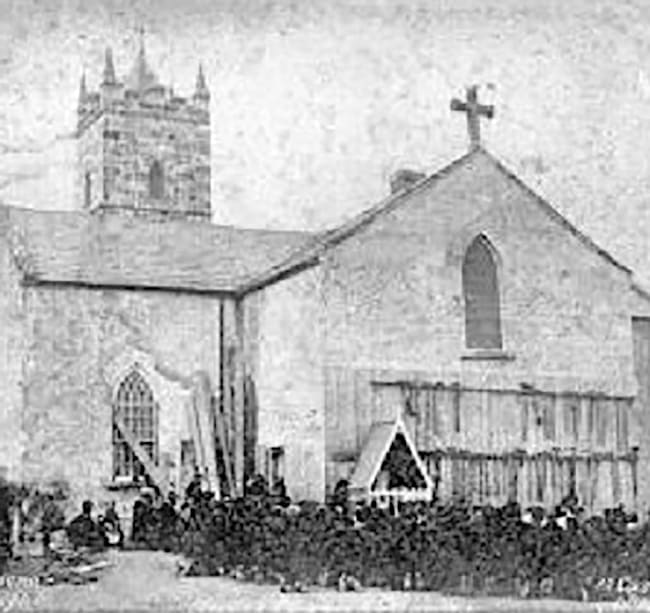 Pilgrims pray at the Apparition Wall at St. John the Baptist Parish church, Knock (circa 1880)
Pilgrims pray at the Apparition Wall at St. John the Baptist Parish church, Knock (circa 1880)The fact that the apparition took place on the eve of the feast of Mary's Immaculate Heart was a significant sign to the Irish that the Blessed Virgin held them all very close to her Motherly Heart. She was coming to them as a Mother, to give hope and courage to her persecuted and suffering children and to stand with them in silent solidarity. She came with St. Joseph whose silent presence, according to the eminent Irish Mariologist, Fr. Michael O'Carroll C.S.Sp., "compels us to reflect on him, to seek help in prayer towards an understanding of his role in the life of the Church and in our own personal lives...to base our lives and conduct on the closest relationship possible with Mary, Queen of the Universe." Fr. O'Carroll also added that "This was Heaven's confirmation of the solemn act of the Vicar of Christ, Venerable Pope Pius IX, who on December 8, 1870 declared St. Joseph Patron of the Universal Church".
— And so may we also conclude the significance of Pope Francis's message given to the people of Ireland on the feast of St. Joseph!
The third personage, St. John the Evangelist, was one to whom the courageously faithful Irish Catholics could easily relate. St. John held open in his hand the Book of Gospels or Mass Book, denoting to them that grace and hope come from Jesus in the Holy Sacrifice of the Mass.
Then there is the silence of these three heavenly personages to consider — a silence in the presence of the Eucharistic Lamb upon the altar. This indicated the importance of that reverence due to our Eucharistic Lord as well as the importance of uniting reverent prayer and sacrifice to the Eucharistic Sacrifice of Our Lord Jesus Christ. No words were uttered by the three celestial beings who appeared at Knock, but their silence was profound.
In Saint John Paul II's Apostolic Letter, Orientalis Lumen (Light of the East), he dedicated an entire page to silence. He pointed out that "One draws close to this presence [of the Father, the Son, and the Holy Spirit] above all by letting oneself be taught an adoring silence... we all have need of this silence, filled with the presence of him who is adored."
In September 1979, Saint John Paul II came as a pilgrim to Knock, and bestowed upon the newly built church the title Basilica of Our Lady, Queen of Ireland. In the sermon he gave at the Mass on that day he reminded the people of Ireland that: "Not many of her [Mary's] own words have been preserved in the Gospels; but those that have been recorded refer us... to her Son and to His Word. At Cana in Galilee, she turned from her Son to the servants and said'Do whatever he tells you'(John 2:5)... Return in thought from Cana in Galilee to the Shrine of Knock... do we not hear the Mother of Christ pointing him out to us here too and speaking to us the same words that she used at Cana: 'Do whatever he tells you'"?
A Mhuire an Chnoic, guigh orainn!
(UH WEERuh UN KUHnik GWEE UHRinn)
Our Lady of Knock, pray for us!
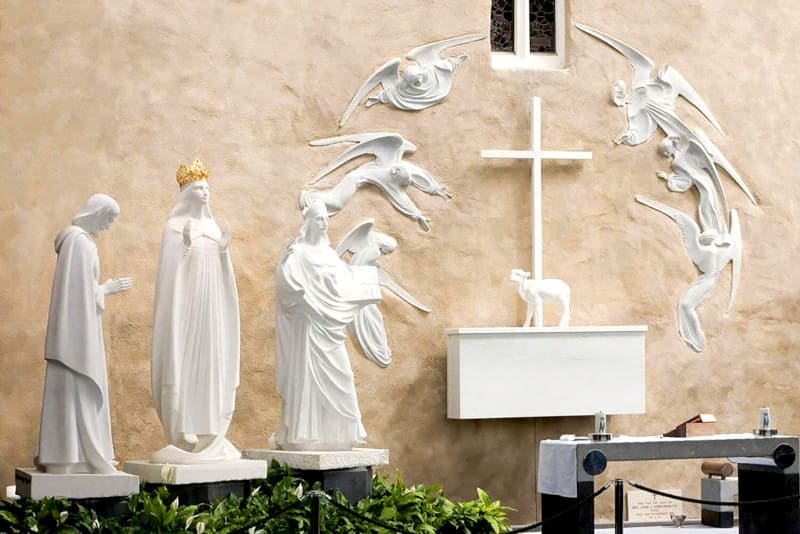
Eyewitness accounts and photos from: http://www.knockshrine.ie
Hymn to Our Lady of Knock - http://www.irishpage.com